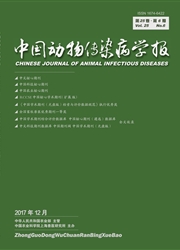

 中文摘要:
中文摘要:
H9N2亚型禽流感疫苗在我国普遍使用,在强大免疫压力下,H9N2亚型禽流感病毒变异加快,现有商品化灭活苗无法完全保护免疫鸡免受H9N2亚型禽流感病毒流行株的感染。为此,本研究以从近期流行毒株中筛选出的一株H9N2亚型禽流感病毒A/Chicken/shanghai/441/2009(H9N2)(简称为SH441)为种毒,制备灭活苗,进行了最小免疫剂量及抗体消长规律的初步研究。将制备的H9N2亚型禽流感灭活苗以0.01、0.02、0.04、0.05、0.08mL/只的不同剂量,胸部肌肉途径免疫3周龄SPF鸡只,并于免疫后21天静脉感染SH441病毒,结果显示该疫苗最小免疫剂量为0.02mL/只。以0.05mL/只剂量免疫SPF鸡只,该疫苗能刺激SPF鸡只产生较高的HI抗体滴度,且在免疫后第5周达到峰值(12Log2以上),随后稍有下降但保持相对稳定,且在免疫后29周时依然保持在7Log2以上。这些结果为为该疫苗的进一步开发奠定了良好的基础。
 英文摘要:
英文摘要:
The H9N2 subtype avian influenza vaccines have been used widely in China. Under intense immune pressure, variation of H9N2 subtype avian influenza viruses (AIV) has accelerated. At present, commercial H9N2 subtype avian influenza vaccines do not provide chickens complete protection against AIV infection. Therefore, we chose A/Chicken/Shanghai/441/2009(H9N2)(SH441) from a few of recent virus isolates to develop an inactivated vaccine. In the present study, we determined the minimum dose of this inactivated vaccine and antibody dynamics in immunized chickens. Three-week-old SPF chickens were injected intramuscularly with 0.01, 0.02, 0.04, 0.05 or 0.08 mL of H9N2 AIV inactivated vaccine. After 21 days post-immunization, chickens were challenged with SH441 virus. The results demonstrated that the minimum dose of this vaccine was 0.02 mL per chicken. When immunized with 0.05 mL dose, chickens developed high level of HI antibodies. HI antibody titers peaked (〉12Log2) at 5 weeks post-immunization and then remained above 7 Log2 by 29 weeks post-immunization. All of these data provided a very good basis for further development of an inactivated H9N2 subtype AIV vaccine.
 同期刊论文项目
同期刊论文项目
 同项目期刊论文
同项目期刊论文
 期刊信息
期刊信息
